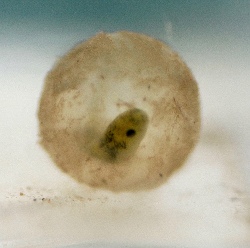Reproduction
Migration to the breeding ponds occurs in late winter or
early spring. During the nocturnal courtship, a male uses his
snout to nudge and butt other salamanders, which are sometimes
lifted off the pond bottom in the process. Eventually a male
will walk under the females chin , leading her forward, and she
may follow, nudging his tail and vent area. This behavior
stimulates the male to deposit a spermatophore. The female may
wriggle the posterior part of her body until her vent contacts
the spermatophore, allowing her to take sperm in her cloaca. The
pair maintains contact as they move forward, with the female
continuing to nudge the male's vent, and producing additional
spermatophores. There is much breeding competition in this
species. Males will purposefully interfere with courting pairs
and frequently cover the spermatophores of other males with
their own.

The males actively compete for females, and after mating, the female lays 1 or more egg masses of 25-50 eggs each (depending upon the subspecies). These are attached to underwater plants, stones, logs, or other debris. The eggs hatch in approximately four weeks into larvae with feathery gills. The larvae feed on aquatic insects, small invertebrates, and fish. The larvae remain in the ponds until late July or early August, and then transform into air breathing sub-adults, 4-5 inches in length. At this time they start to move towards a more terrestrial existence. Some larvae may overwinter (sustain through winter) and not transform into adults until the following spring. Tiger Salamanders reach sexual maturity at 4-5 years of age.
If you would like to learn about the interactions of the tiger salamander with other organism click here
To go back and learn about the nutrition of the tiger salamander click here
To go back to the home page click here